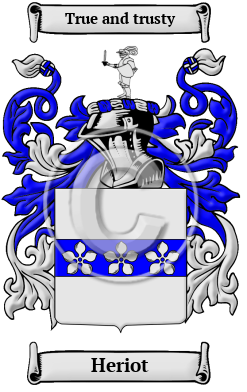| ![Show Contents]() Heriot History, Family Crest & Coats of Arms Heriot History, Family Crest & Coats of Arms
- Origins Available:
England
Early Origins of the Heriot familyThe surname Heriot was first found in Midlothian where they held a family seat from early times and held the lands of Heriot, and were found there as early as c. 1164, when Henry of Heriot witnessed confirmation of the church of Karnewid (Carnwath) to Joceline, bishop of Glasgow. "Laurence de Herryhot witnessed a grant of the lands of Swaynystoun to the Hospital of Soltre c. 1221-1238. The lands of Trabroun in the sheriffdom of Berwick were confirmed to John de Heriot de Trabroun, son and heir of James de Heriot de Nudre Marschele in 1424." 1 Further to the south in England, Richard de Heriett, de Herierd was found in Berkshire and Bedfordshire according to the Feet of Fines of 1197-1198. 2 In Somerset, Walter Henriot was listed there 1 Edward III (during the first year of the reign of King Edward III) 3 and in Norfolk Heriot Heringflet (no date). 4 Early History of the Heriot familyThis web page shows only a small excerpt of our Heriot research. Another 264 words (19 lines of text) covering the years 1221, 1424, 1429, 1458, 1468, 1504, 1525, 1537, 1549, 1550, 1560, 1563, 1570, 1580, 1585, 1586, 1588, 1591, 1621 and 1624 are included under the topic Early Heriot History in all our PDF Extended History products and printed products wherever possible. Heriot Spelling VariationsDuring the era when a person's name, tribe and posterity was one of his most important possessions, many different spellings were found in the archives examined. Heriot occurred in many references, and spelling variations of the name found included Herriot, Heriot, Harriet, Hariet, Herriott, Harriott and many more. Early Notables of the Heriot family- John of Heriot of Trabrown, Chief of the Clan in 1424
- George Heriot (1563-1624), was a Scottish goldsmith and philanthropist. He was "founder of Heriot's Hospital, Edinburgh, was born in that city 15 June 1563. His father, George Heriot, who belonged to...
| Heriot migration to New Zealand | + |
Emigration to New Zealand followed in the footsteps of the European explorers, such as Captain Cook (1769-70): first came sealers, whalers, missionaries, and traders. By 1838, the British New Zealand Company had begun buying land from the Maori tribes, and selling it to settlers, and, after the Treaty of Waitangi in 1840, many British families set out on the arduous six month journey from Britain to Aotearoa to start a new life. Early immigrants include: Heriot Settlers in New Zealand in the 19th Century- Mr. S. Heriot, Scottish settler travelling from Greenock aboard the ship "Robert Henderson" arriving in Port Chalmers, Dunedin, Otago, South Island, New Zealand on 9th February 1858 5
- Mrs. Heriot, Scottish settler travelling from Greenock aboard the ship "Robert Henderson" arriving in Port Chalmers, Dunedin, Otago, South Island, New Zealand on 9th February 1858 5
| Contemporary Notables of the name Heriot (post 1700) | + |
- Nicole Heriot, American stage actress, singer, and dancer 6
- Edward Thomas Heriot (1793-1854), prominent South Carolina planter and physician
- Corporal James Davidson Heriot (1890-1918), United States Army soldier who received the Medal of Honor for his actions during World War I
- Joan E. Heriot (b. 1911), Canadian scientist and artist
- Jas Heriot Duke (1939-1992), Australian performance poet
- Heriot Clarkson (1863-1942), American Democratic Party politician, Member of North Carolina State House of Representatives, 1899; Justice of North Carolina State Supreme Court, 1923-40 7
The motto was originally a war cry or slogan. Mottoes first began to be shown with arms in the 14th and 15th centuries, but were not in general use until the 17th century. Thus the oldest coats of arms generally do not include a motto. Mottoes seldom form part of the grant of arms: Under most heraldic authorities, a motto is an optional component of the coat of arms, and can be added to or changed at will; many families have chosen not to display a motto.
Motto: True and trusty
- Black, George F., The Surnames of Scotland Their Origin, Meaning and History. New York: New York Public Library, 1946. Print. (ISBN 0-87104-172-3)
- Reaney, P.H and R.M. Wilson, A Dictionary of English Surnames. London: Routledge, 1991. Print. (ISBN 0-415-05737-X)
- Dickinson, F.H., Kirby's Quest for Somerset of 16th of Edward the 3rd London: Harrison and Sons, Printers in Ordinary to Her Majesty, St, Martin's Lane, 1889. Print.
- Rye, Walter, A History of Norfolk. London: Elliot Stock, 62, Paternoster Row, 1885. Print
- New Zealand Yesteryears Passenger Lists 1800 to 1900 (Retrieved 26th March 2019). Retrieved from http://www.yesteryears.co.nz/shipping/passlist.html
- Nicole Heriot. (Retrieved 2010, September 27) Nicole Heriot. Retrieved from http://www.nicoleheriot.com/
- The Political Graveyard: Alphabetical Name Index. (Retrieved 2016, January 29) . Retrieved from http://politicalgraveyard.com/alpha/index.html
 |

